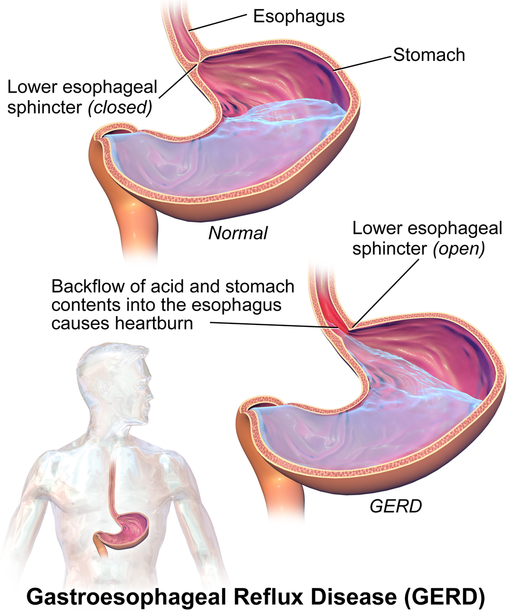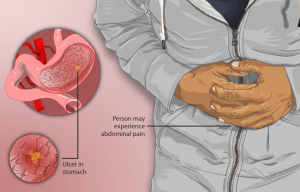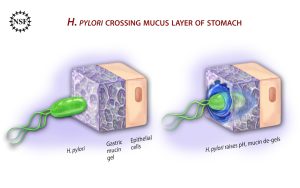3.3 Digestive System Pathologies
There are a number of pathologies that can affect the digestive system; the more common ones will be discussed below. Many of these pathologies can be treated with medications that will be discussed later in this chapter.
Constipation: The definition of constipation may vary, but it is often defined as fewer than three bowel movements in a week and hard stool that is difficult to pass. If defecation is delayed for an extended time, additional water is absorbed, making the feces firmer and potentially leading to constipation. Constipation has several causes, including lack of fluids or fibre in the diet, lack of ambulation, various disease processes, recovery from surgical anesthesia and opiates, and the side effects of many medications. Because there are several potential causes of constipation, treatment should always be individualized to the patient. Many times, constipation can be treated with simple changes in diet, exercise, or routine.
Diarrhea: This is the passage of three or more loose or liquid stools per day (or more frequent passage than is normal for the individual). Frequent passing of formed stools is not considered diarrhea. Diarrhea has multiple causes, such as bacteria or parasites from contaminated food or water, viruses, medicines such as antibiotics or cancer drugs, and food intolerances and sensitivities. The most severe complication that results from diarrhea is dehydration caused by the loss of water and electrolytes (WHO, 2017).
Gastroesophageal reflux disease (GERD): This condition is often referred to as heartburn, indigestion, or sour stomach. GERD is caused by excessive hydrochloric acid that backs up, or refluxes, into the lower esophagus. A common cause of GERD is the ineffective working of the lower esophageal sphincter (Fig. 3.5), which then allows the stomach contents, including hydrochloric acid, to backflow into the esophagus.

Inflammatory bowel disease (IBD): This chronic bowel condition cannot be cured, but the signs and symptoms can be treated to make the patient more comfortable. There are two types of IBD: ulcerative colitis and Crohn’s disease. Fig. 3.6 shows the most common areas of the small intestine and colon affected by ulcerative colitis and Crohn’s disease.
- Ulcerative colitis causes irritation, inflammation, and ulcers in the lining of the colon (large intestine) and affects mainly the lower section of the colon. The symptoms can vary, but patients often experience bloody diarrhea, cramping, lack of appetite, and weight loss (WebMD, 2023).
- Crohn’s disease results in inflammation and irritation of the upper portion of the intestines. The signs and symptoms can include diarrhea, stomach cramps, fever, loss of appetite, and weight loss (Cleveland Clinic, 2023).

Irritable bowel syndrome (IBS): Unlike IBD, the cause of IBS is unknown and the symptoms may not be chronic. Signs and symptoms include abdominal cramping, diarrhea, constipation, gas, and bloating (Healthline, 2023). IBS is often treated with diet, lifestyle changes, and over-the-counter medications. Fig. 3.7 provides details of the symptoms and the location of discomfort for those with IBS.

Nausea and vomiting (N&V): Nausea and vomiting is more a sign and symptom rather than a pathology that a patient may experience; however, it is important to discuss the potential causes because they affect how it is treated. Nausea and vomiting is very common both in the hospital and in the general community. Nausea is defined as the unpleasant sensation that feels like the need to vomit. Vomiting is the often-forceful expulsion of stomach contents.
There are a number of potential causes of nausea and vomiting:
- Morning sickness during pregnancy
- Gastroenteritis and other infections
- Migraine headaches
- Motion sickness
- Food poisoning
- Side effects of medicines, including those used for cancer chemotherapy
- GERD and ulcers
- Intestinal obstruction
- Poisoning or exposure to a toxic substance
- Diseases of other organs (cardiac, renal, or liver)
Peptic ulcers: These ulcers are open sores that occur in the inner lining of the stomach and parts of the small intestine (Mayo Clinic, 2023). The mucosal barrier works to protect the stomach and intestines; however, in some cases, gastric juices eat away at the superficial lining of the stomach mucosa, creating erosions, which often heal on their own. However, deeper and larger erosions are called ulcers. The signs and symptoms can vary, but the main symptom that patients experience is stomach pain (Fig. 3.8). There are different causes of peptic ulcers, but the most common are the bacterium Helicobacter pylori and long-term use of nonsteroidal anti-inflammatory drugs (NSAIDs) such as ibuprofen (Mayo Clinic, 2023). Factors such as stress and diet do not cause peptic ulcers, but they can make the symptoms worse (Mayo Clinic, 2023).

A potential complication of ulcers is perforation (Betts et al., 2013). Perforated ulcers create a hole in the stomach wall, resulting in peritonitis. These ulcers must be repaired surgically (Betts et al., 2013).
Key Concept

Helicobacter pylori, a common cause of ulcers, is very common within the general population. Many of us have it but will not have any signs or symptoms. However, once it crosses the stomach lining, as shown in Fig. 3.9, it can cause ulcers, which can be very difficult to treat. Some of the potential treatments are discussed in the next section of this chapter.
The video below provides more details on ulcers and their potential causes.
(Ted-Ed, 2017)
Attribution
Unless otherwise indicated, material on this page has been adapted from the following resource:
Ernstmeyer, K., & Christman, E. (Eds.). (2020). Nursing pharmacology. Chippewa Valley Technical College. https://wtcs.pressbooks.pub/pharmacology/, licensed under CC BY 4.0
References
Betts, J. G., Young, K. A., Wise, J. A., Johnson, E., Poe, B., Kruse, D. H., Korol, O., Johnson, J. E., Womble, M., & DeSaix, P. (2013). Anatomy and physiology. OpenStax. https://openstax.org/details/books/anatomy-and-physiology, licensed under CC BY 4.0
Cleveland Clinic. (2023). Crohn’s disease. https://my.clevelandclinic.org/health/diseases/9357-crohns-disease
Healthline. (2023). Everything you want to know about IBS. https://www.healthline.com/health/irritable-bowel-syndrome#symptoms
Mayo Clinic. (2023). Peptic ulcer. https://www.mayoclinic.org/diseases-conditions/peptic-ulcer/symptoms-causes/syc-20354223
Ted-Ed. (2017, September 28). The surprising cause of stomach ulcers – Rusha Modi [Video]. YouTube. https://www.youtube.com/watch?v=V_U6czbDHLE
WebMD. (2023). Ulcerative colitis (UC). https://www.webmd.com/ibd-crohns-disease/ulcerative-colitis/what-is-ulcerative-colitis
World Health Organization (WHO). (2017, May 2). Diarrhoeal disease. https://www.who.int/en/news-room/fact-sheets/detail/diarrhoeal-disease
Image Credits (images are listed in order of appearance)
GERD by BruceBlaus, CC BY-SA 4.0
Crohn’s Disease vs Colitis ulcerosa by Samir, CC BY-SA 3.0
Depiction of a person suffering from Irritable Bowel Syndrome (IBS) by myUpchar, CC BY-SA 4.0
Depiction of a patient suffering from peptic ulcers by myUpchar, CC BY-SA 4.0
Ulcer-causing Bacterium (H. Pylori) Crossing Mucus Layer of Stomach by Zina Deretsky, National Science Foundation, Public domain
when undigested materials are removed from the body as feces
a type of bacteria that can cause peptic ulcers
inflammation of the peritoneum

